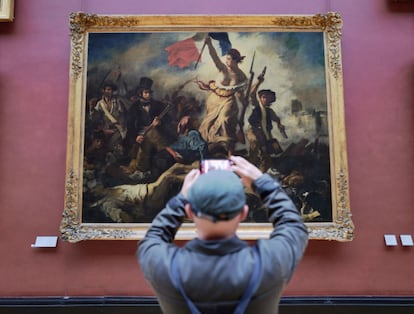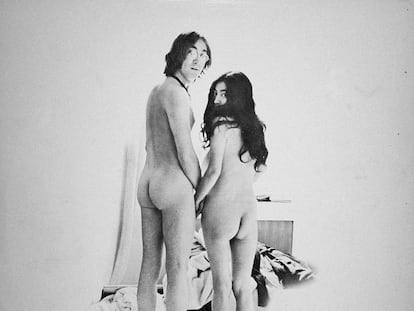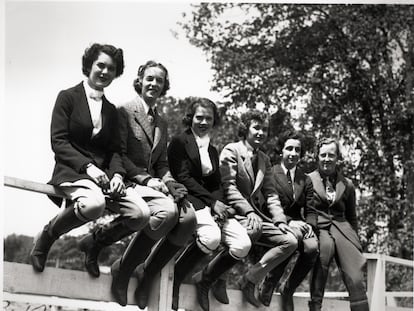Why does Delacroix’s ‘Liberty Leading the People’ feature bare breasts?
The Marianne’s nudity in French Romanticism’s most famous painting caused a monumental stir as early as 1830. But is it an artistic code?

When controversy erupted in France over the banning of the burkini in 2016 on the country’s beaches, the then-Prime Minister, Manuel Valls, invoked the symbol of liberty, otherwise known as the Marianne, leading the people with bare breasts in Eugène Delacroix’s famous 1830 painting to argue his position. In Valls’ opinion, the nudity of this woman leading the masses towards freedom was the ultimate representation of republican values, including, of course, freedom of expression which includes the freedom to bare one’s body.
This same example was used by the singer Rigoberta Bandini when she performed at Eurovision celebrating bare breasts with a song in which she made direct allusion to the painting in question; and also by Spanish singer/ songwriter Eva Amaral last weekend at Sonorama when, her breasts exposed, she spoke about “our revolution” while invoking the name of colleagues who had been vilified for appearing naked from the waist up.
In 2016, there was no shortage of people reproaching Valls for the alleged audacity of using the painting as an argument: Mathilde Larrere, a historian and expert on the French Revolution, publicly told him that the use of the Marianne as a feminist symbol was “stupid” as it was an allegory and her bare breasts an “artistic code” that had nothing to do with female freedom.
“The Marianne with bare breasts is an allegory of the 19th century, a century in which the Civil Code reduced women to a lesser status and forbade them to vote,” she tweeted at the time. This week, it has been the writer Carmen Domingo who has publicly argued that showing one’s breasts is not a gesture that represents women’s struggle for equal rights.
Larrere and Domingo’s position aside, what is clear is that the decision of a romantic painter in the 19th century to have a woman leading the people with her breasts loose generated enormous controversy. Never mind “artistic codes,” these were simply sexist objections. For example, one critic writing in the Parisian newspaper L’Avenir described this female representation as “repugnant;” that same year, the Journal des Artistas said: “The woman represents the lowest type of prostitute.”
In general, the artistic community was furious: Delacroix had dared to sully not only a generic symbol of freedom but the one woman who represented France. Of course, in the 19th century, the term “feminism” as we understand it in the 21st century did not exist. It is also a fact that women’s suffrage was not allowed because women were generally considered second-class citizens. But 200 years ago, even the most backward minds were able to understand that a woman who shows her breasts when she feels like it, is a woman who does exactly the same as a man and is, therefore, more free.
Facebook’s algorithm that censors nipples as “scandalous” was also unable to identify the alleged “artistic code.” In 2018, these algorithms were responsible for cancelling an advertising campaign for a play by director Jocelyn Fibrina that used Delacroix’s romantic painting. In the end, Mark Zuckerberg’s social network had to apologize when it was argued that the naked woman was not just any woman but a symbol of France’s struggle for freedom.
Julio Carlo Argan, one of the most relevant art historians of the 20th century, said that Liberty Leading the People is the first political painting in modern art, since it promotes freedom. The work represents the three glorious days of bourgeois insurrection that put an end to the white terror after sixteen years of Bourbon reign with the ultraconservative Charles X on the throne. Delacroix was not just another spectator: he was on the side of the revolutionaries, and he himself is represented in the painting as wearing the black top hat.
Although the identity of Delacroix’s bare-breasted rebel is not known for certain, some art historians, such as Etienne Julie, have argued that the Marianne of this mythical painting is a washerwoman named Anne-Charlotte who came to the barricades in search of her brother, a revolutionary who died at the hands of royalist soldiers. In other words, the breasts exposed are a worker’s breasts.
The curious thing is that hers is not the only example of nakedness in the painting: in the foreground, you can see a man with a naked pubis, though we do not see his penis.
Sign up for our weekly newsletter to get more English-language news coverage from EL PAÍS USA Edition
Tu suscripción se está usando en otro dispositivo
¿Quieres añadir otro usuario a tu suscripción?
Si continúas leyendo en este dispositivo, no se podrá leer en el otro.
FlechaTu suscripción se está usando en otro dispositivo y solo puedes acceder a EL PAÍS desde un dispositivo a la vez.
Si quieres compartir tu cuenta, cambia tu suscripción a la modalidad Premium, así podrás añadir otro usuario. Cada uno accederá con su propia cuenta de email, lo que os permitirá personalizar vuestra experiencia en EL PAÍS.
¿Tienes una suscripción de empresa? Accede aquí para contratar más cuentas.
En el caso de no saber quién está usando tu cuenta, te recomendamos cambiar tu contraseña aquí.
Si decides continuar compartiendo tu cuenta, este mensaje se mostrará en tu dispositivo y en el de la otra persona que está usando tu cuenta de forma indefinida, afectando a tu experiencia de lectura. Puedes consultar aquí los términos y condiciones de la suscripción digital.











































